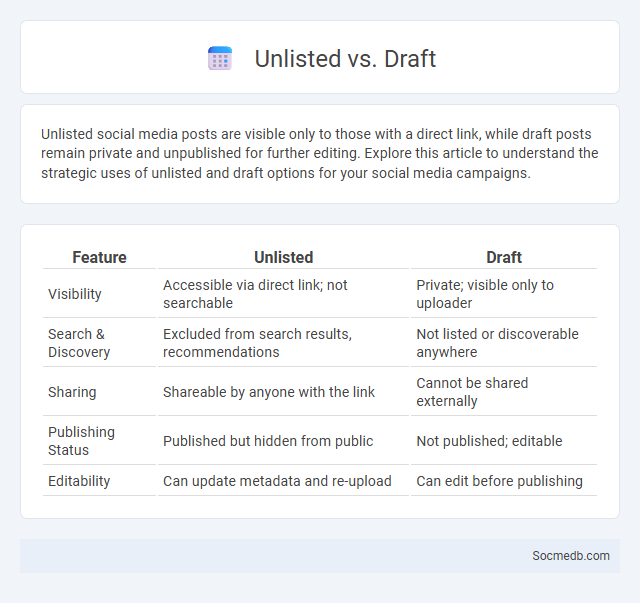
Photo illustration: Unlisted vs Draft
Unlisted social media posts are visible only to those with a direct link, while draft posts remain private and unpublished for further editing. Explore this article to understand the strategic uses of unlisted and draft options for your social media campaigns.
Table of Comparison
| Feature | Unlisted | Draft |
|---|---|---|
| Visibility | Accessible via direct link; not searchable | Private; visible only to uploader |
| Search & Discovery | Excluded from search results, recommendations | Not listed or discoverable anywhere |
| Sharing | Shareable by anyone with the link | Cannot be shared externally |
| Publishing Status | Published but hidden from public | Not published; editable |
| Editability | Can update metadata and re-upload | Can edit before publishing |
Introduction to Video Privacy Settings
Video privacy settings on social media platforms control who can view, comment on, and share your video content, ensuring personalized audience engagement. Users can typically select options such as public, friends only, or private, tailoring visibility according to privacy preferences and content sensitivity. Properly managing these settings enhances security by preventing unauthorized access and helps maintain the intended reach of your video posts.
Understanding Unlisted Videos
Unlisted videos on social media platforms like YouTube are accessible only to users with the direct link, ensuring controlled sharing without public exposure. These videos do not appear in search results, channel listings, or recommendations, maintaining privacy while allowing targeted audience engagement. Understanding unlisted video settings helps creators manage content distribution effectively and protect sensitive or exclusive material.
What Is a Draft Video?
A draft video is a saved, unfinished video project stored within a social media platform or video editing app, allowing you to revisit and complete it later. This feature lets you make adjustments, add effects, or finalize content without immediately publishing. Maintaining draft videos ensures you can perfect your posts before sharing with your audience.
The Difference Between Draft and Unlisted Videos
Draft videos on social media platforms are saved privately and not accessible to others until published, allowing creators to edit or review content before sharing. Unlisted videos are uploaded and exist online but are not publicly searchable; only users with the direct link can view them. This distinction enables controlled sharing, with drafts serving as preparatory stages and unlisted videos offering selective visibility without full public exposure.
Pros and Cons of Unlisted Videos
Unlisted videos on social media platforms allow you to share content selectively, ensuring privacy while enabling easy access through a direct link. This feature benefits creators by providing control over audience reach without restricting content visibility entirely, unlike private videos. However, unlisted videos may still be shared beyond intended viewers, posing risks to confidentiality and limiting audience growth potential.
Benefits of Using Draft Videos
Draft videos enable you to refine content before publishing, ensuring higher quality and engagement on social media platforms. They provide the opportunity to review and edit visuals, audio, and messaging, which boosts brand consistency and viewer retention. Using draft videos streamlines your content creation workflow, saving time and enhancing your overall social media strategy effectiveness.
Use Cases for Unlisted Videos
Unlisted videos on social media platforms serve critical use cases such as targeted content sharing, where creators distribute videos to specific audiences without public visibility. Brands leverage unlisted videos for internal training sessions, exclusive previews, and client presentations, ensuring controlled access. Influencers and marketers utilize unlisted videos for beta testing new content, gathering feedback before a public release, optimizing engagement and content quality.
Situations to Choose Draft vs. Unlisted
Choosing between Draft and Unlisted options on social media depends on your content strategy and audience engagement goals. Use Draft mode when you need to refine your posts, collaborate with your team, or wait for optimal timing before sharing. Opt for Unlisted when you want to share content selectively with specific viewers without making it publicly searchable, ideal for exclusive previews or private promotions.
Managing Video Visibility and Access
Managing video visibility and access on social media platforms involves setting precise privacy controls, such as public, private, or unlisted options, to tailor audience reach effectively. Advanced features like age restrictions, geographic limitations, and password protection help creators regulate who can view their content, enhancing security and compliance. Analytics tools provide insights into viewer demographics and engagement, allowing for strategic adjustments in visibility settings to maximize impact and protect intellectual property.
Best Practices for Video Publishing Settings
Optimizing your video publishing settings on social media involves selecting the highest resolution and appropriate aspect ratio to ensure quality playback across devices. Using platform-specific codecs, enabling captions, and scheduling posts during peak engagement times can significantly boost visibility and user interaction. Tailoring these settings helps maximize the reach and impact of your videos, ensuring your content stands out in crowded feeds.
 socmedb.com
socmedb.com